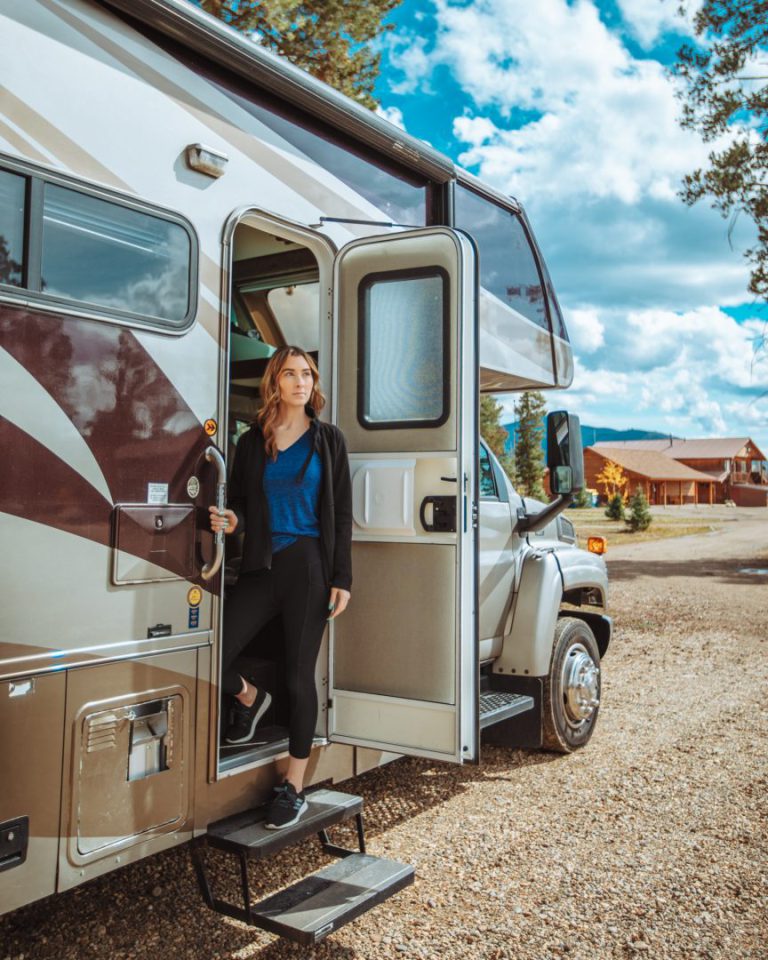
If you ask us, one of the most underrated RV accessories is also one of the very first you encounter when entering your RV: RV steps! Without a great set of RV or motorhome steps, getting in and out of your motorhome comfortably can be a difficult task. You might even hurt your knees or have an accident. There are plenty of options to make it easy, too, including electric RV steps, folding RV steps, and a variety of awesome accessories to make them even better, like RV step lights, RV step rugs, RV step carpet and so much more.
With so many options, choosing the right steps for your RV can seem like a daunting task — not to mention figuring out how to install them, or just measure them to make sure you have the right fit. Fortunately, we’re taken a deep dive into all the things you didn’t know you needed to know about RV steps so you can shop, install, and step in confidence. Here’s what you need to know!
Different Types of RV Steps
First, it’s important to decide if you’d like to utilize portable RV steps or permanently installed RV steps. The difference is within the name! Installed RV steps are, as the name implies, permanently installed and always a part of your motorhome, whereas portable steps can be folded up and stored and are simply assembled nearby your motorhome or travel trailer as needed.
A majority of modern RV owners want permanently installed RV steps on their rigs. Of this type, there are two subtypes to choose from: manual RV steps and automatic steps for your RV.
Manual RV steps, also known as an “RV add a step,” are one of the most versatile options. They resemble a small ladder and typically have hinges which makes it easy to add or remove steps. Manual RV steps are attached to the RV by being framed, bolted or welded to the door. To operate them, you simply fold them out manually — just like the name implies!
Electric RV steps, on the other hand, never even needs to be touched – they automatically retract and open with the push of a button or flip of a switch. Part of these include an RV electric step motor, which lets them open immediately when the RV door opens.
These types of RV steps are also welded to the frame or bolted to the door of your RV. The Kwikee RV step is one of the most popular brands of electric RV steps, and they are operated by an electrical switch inside the RV. Both manual and electric RV steps can be installed by a professional or as a DIY project.
What are the Best RV Steps?
Although it all comes down to personal preference, here are 5 of the Best Rated RV Steps in the Market for 2022:
Mor/Ryde steps top many lists because they’re durable and stable. They’re also easy to install, and they fold securely into the RV for safe travel. You simply twist the handle to release your steps when you need them. The 3-step set adjusts to between 34-36 inches high and their adjustable feet mean the stairs will sit securely on the ground, even when it’s uneven. The stairs are waterproof and have anti-slip treads for added safety.
Price: $428
2.) Ollieroo Folding Steel Step Ladder
This folding stair step is portable, and the legs fold under for easy, flat storage. The stool is anti-slip, allowing you to use it safely even in wet or snowy weather, and is lightweight. It supports up to 330 pounds. The simple step stool is a good choice for smaller trailers or motorhomes and is an inexpensive choice for people who don’t want a lot of fuss when setting up their RV steps.
Price: $25.99
3.) Stromberg Carlson EHS-102-R Second Step
This set of steps has the added safety feature of a portable RV steps handrail to help you get in and out of your motorhome. The stairs are twenty pounds and are somewhat bulky to store because of the added handrail. The handrail is interchangeable, so you can install it on the left or right side. This stair set says it’s a 2-step staircase, but the top platform acts as a third step. Steps are non-slip for added safety.
Price: $319
4.) Camco Aluminum Platform Step Support
This Camco platform step can solidly support a lot of weight – up to 1,000 pounds. While it’s durable and sturdy, the aluminum step is lightweight at only 8 1/2 pounds, and folds down to just three inches high for easy storage. The feet have adjustable lengths and non-slip rubber coverings so the step will stay in place.
Price: $75.45
5.) Stromberg Carlson SMFP-2100 Manual Coach Steps
These sturdy, lightweight folding steps are durable and feel solid under your feet when you’re using them. The steps support up to 250 pounds. They’re easy to install with basic tools. When they’re not being used, the steps fold under the door for safe storage.
Price: $191
Benefits & Features of Portable RV Steps
Portable RV steps don’t need to be installed and are typically more affordable than electric steps. When not in use, they can be folded up (in some cases) and stored away. There are several types of portable RV steps, including:
Adjustable-leg RV platform step, which is made of aluminum alloy with adjustable legs that are slip-proof.
A folding RV step, which is the most cost-effective, hassle-free option for an RV step. These types of steps resemble a stool, and can be unfolded for use and folded back up for storage. They typically have two handles and are easy to store when not in use.
Porch-style steps with handrails are a very sturdy option for RV steps, and have handrails on either side. They’re an excellent choice if you’ll have young children or elderly adults visiting your RV.
Solid plastic box steps have no moving parts, and are made from a solid piece of durable and high-quality plastic. They are typically available in 2-step and 3-step models, for whatever option works best for your RV.
A portable RV step stabilizer can also be quite helpful, especially for fold-down steps. It provides a firmer feel when entering and exiting your RV and will help slow down wear and tear. It manually screws up and down to adjust to the required height. Also you must be careful to prevent the steps from folding up automatically, because this can cause the stair motor to burn out. Also, be careful when retracting the jacks, because you could bend your steps by mistake. To prevent these issues, remove the RV step stabilizer before you pack up camp. In this way, you will not forget it and start the engine by mistake.
RV Steps: Pricing
We’ve laid out all the various different kinds of RV steps out there! But hold on a second. What is this project going to set you back?
A set of manual, permanently installed RV steps might cost less than $100, or right around that price. An electric set, on the other hand, might run you closer to $500 or more before installation.
And portable RV steps also come at a wide range of price points; for instance, if you’re just getting a simple stool, you might spend as little as $60 or so, whereas a porch-style step with handrails might cost you more on the order of $350 or more.
What to Look For When Buying RV Steps
What should you look for when buying RV steps?
Well, along with a great deal, you also want to look for high quality materials and a setup that’s in good, working order. It’s easy to buy things online these days, but if you get a chance to shop for your steps in person, you’ll be able to see the workmanship for yourself and ensure the product is free of rust or any other obvious physical problems.
Keep in mind that RV steps are only one of the many RV parts and accessories that can make or break your RV camping experience. For more information on everything from sofa beds to water pressure regulators, click here to browse our RV parts and accessories blog category.
RV Steps: FAQs
Let’s finish out our article on RV steps with answers to some of the most frequently asked questions about this important RV accessory!
How do you measure RV steps?
If you need to replace your RV steps — or just install some in the first place — you’ll want to start by measuring the steps to ensure the right fit. The exact number of measurements you’ll need to take, and where they come from, depends on which model of step you choose; but in general, you’ll need the overall width of the setup, the height from step to step, and the diagonal length of your step from the crossbar to the bottom. (Check out this guide from etrailer for a detailed schematic on what kind of measurements you’ll need.)
How do you replace RV steps?
To replace your RV steps, you’ll first need to uninstall any steps that are already in place. Find the bolts that attach them to your rig and unscrew them to lift the steps off so you can install the new ones.
Then, place your new RV steps into the same location and utilize the appropriate fittings to secure it to your rig. Always be sure to follow any instructions included with your specific set of RV steps.
For an RV that already has steps you’re replacing:
- Measure the width of the step assembly
- Measure the height of the steps
- Measure from the center of the step assembly at the crossbar diagonal to the edge of the bottom stair
For an RV that doesn’t yet have steps:
- Measure from the two mounting bolt holes to the ground at approximately a 30-degree angle
How do you install RV steps?
Although the exact instructions for installing RV steps will vary depending on what steps you have, the basic process is essentially the same and looks a bit like this:
- Remove the transition strip between the floor and the door threshold
- Put the top portion of your new RV step inside the center of the door opening
- Lock the step into place. Make sure the latches are properly connected to the door jamb
- Mesure up to 15/16″ from inside the threshold to the front of the RV step’s hinge plate
- Make sure the RV step is in the middle of the door opening and there is a 1/8″ clearance on each side
- Lower the RV step to make sure the door shuts
With portable RV steps, you won’t permanently install them, but rather use them as they’re needed.
How wide are RV steps?
The width of RV steps varies by brand and stair type, but they generally tend to be between 20 and 36 inches wide.
For more check out our 5 Best RV Steps for Camper and Trailers blog!
Thanks for reading and happy RVing!
*This post contains affiliate links. RVshare may receive compensation if you make a purchase after clicking on a product link.

